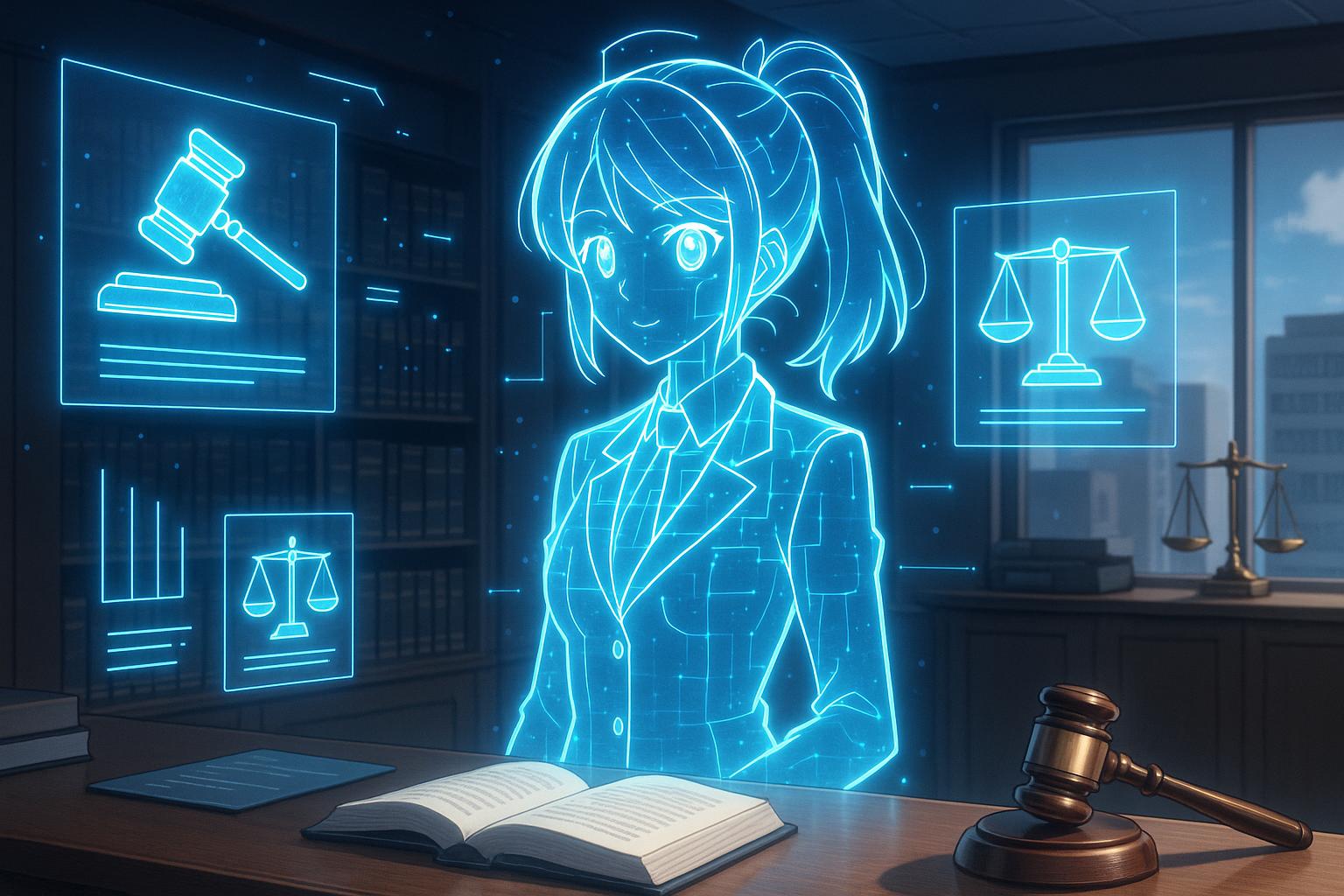The Solicitors Regulation Authority has officially authorised Garfield Law as the first fully AI-driven legal services firm, sparking both excitement and scrutiny about the firm’s pioneering status given decades of prior AI use in law. Industry experts highlight potential benefits for accessibility and affordability alongside ongoing concerns about ethical oversight.
The recent announcement by the Solicitors Regulation Authority (SRA) regarding the authorisation of Garfield Law has stirred significant excitement within the legal community. The SRA declared Garfield Law as the first firm to utilise artificial intelligence (AI) for delivering legal services, a move heralded as a “landmark moment” by Paul Philip, the SRA’s Chief Executive. However, this assertion invites scrutiny and raises questions about the true pioneering nature of this development in the legal sector.
Garfield Law, co-founded by former litigator Philip Young and quantum physicist Daniel Long, aims to streamline the litigation process for small and medium-sized businesses, particularly focusing on debt recovery. The firm makes use of an AI-powered litigation assistant to navigate the complexities of small claims court procedures, a tool designed to enhance accessibility and reduce costs. For instance, it offers services such as sending debt collection letters for just £2 and preparing legal claim forms for £50. Given the astonishing scale of unpaid debts in the UK—estimated between £6 billion and £20 billion annually—Garfield’s model attempts to fill a crucial gap in affordable legal support for individuals and businesses alike.
Yet, the excitement surrounding Garfield Law’s official recognition as an AI law firm must be tempered by a closer examination of the landscape of legal services. AI has been employed in various forms for decades within the legal profession. The SRA’s claim may overlook the existing utilisation of AI across many law firms, which have long integrated AI for tasks such as document review and legal research. The history of AI in law arguably dates back to the introduction of ‘expert systems’ in the 1980s, which were utilised to provide legal advice based on pre-set parameters and decision trees. These prior implementations lay the groundwork for today’s advancements, calling into question the completeness of the SRA’s narrative.
Moreover, the emphasis placed by the SRA on consumer benefits, such as improved accessibility and affordability of legal services, points to a broader movement within the industry. Across the sector, firms like Allen & Overy and Shearman & Sterling are investing heavily in AI to automate routine tasks, aiming to free legal professionals to focus their energies on more complex legal issues. This shift is not merely about technological innovation; it represents a significant potential for improving access to justice, particularly for those who have traditionally struggled to secure legal representation.
While Garfield Law’s approach does have merit, particularly in utilising a fully AI-driven model under solicitors’ oversight and with client consent at every step, there remains a cautious optimism within the industry. Legal professionals have voiced concerns regarding the potential challenges associated with fully automated legal services, including issues of accountability and ethical considerations in the application of AI technologies. Lord Justice Colin Birss, a prominent figure in the legal landscape, has supported the initiative, recognising the potential of AI to address systemic challenges such as court delays and backlog, but there remains a need for vigilant oversight.
Ultimately, the approval of Garfield Law signifies not just an innovation in legal practice but also a pivotal moment in the ongoing conversation about the role of technology in law. The SRA’s endorsement appears to reflect a willingness to engage with the evolving landscape of legal services, while also recognising the vital need for adequate safeguards in this rapidly changing environment.
As Garfield Law sets out to revolutionise access to legal assistance, the industry watches closely. The path forward will require a balance between embracing innovation and ensuring that fundamental legal principles are upheld, ensuring that justice is accessible to all, not just those who can afford it. The journey into AI-powered legal services has indeed begun, but it is essential to stay mindful of the precedents set by decades of legal practice that have walked alongside technological advancement.
Reference Map
- Paragraph 1: 1, 2
- Paragraph 2: 3, 4
- Paragraph 3: 1
- Paragraph 4: 5, 6, 7
- Paragraph 5: 3, 5
- Paragraph 6: 3, 6
- Paragraph 7: 4
- Paragraph 8: 1, 3, 7
Source: Noah Wire Services
- https://www.lawgazette.co.uk/obiter/first-ai-law-firm-er-not-quite/5123324.article – Please view link – unable to able to access data
- https://www.sra.org.uk/sra/news/press/garfield-ai-authorised/ – The Solicitors Regulation Authority (SRA) has authorized Garfield.Law Ltd as the first law firm providing legal services through artificial intelligence (AI). Garfield.Law offers small and medium-sized businesses, as well as law and other firms, the use of an AI-powered litigation assistant to help them recover unpaid debts, guiding them through the small claims court process up to trial. The SRA emphasizes the potential consumer benefits of AI-driven legal services, such as improved accessibility and affordability, while ensuring appropriate checks are in place to protect consumers.
- https://www.ft.com/content/e56cb23e-bc10-4235-997c-186df5bd963c – Garfield AI, an innovative artificial intelligence-based law firm, has gained approval from the Solicitors Regulation Authority in what is being called a ‘landmark moment’ for the legal industry. Co-founded by former London litigator Philip Young and quantum physicist Daniel Long, Garfield AI provides legal services at significantly reduced costs, such as £2 for debt collection letters and £50 for filing legal claim forms. It aims to help individuals, particularly small businesses and tradespeople, recover unpaid debts, which amount to an estimated £6 billion to £20 billion annually in the UK. The AI tool guides users through court procedures and even prepares legal arguments, with initial outputs reviewed for quality control. The firm has received support from judicial figures, including Lord Justice Colin Birss, highlighting its potential to enhance access to justice and reduce court backlogs. This approval reflects broader efforts in the legal sector to integrate AI while maintaining data protection and accuracy, as firms like A&O Shearman also invest in developing AI for routine legal tasks. Garfield represents a pioneering step in deploying AI to handle entire legal cases from start to finish.
- https://www.lawgazette.co.uk/news-focus/in-depth-worlds-first-ai-law-firm-targets-high-street-practices/5123234.article – Garfield Law, a pioneering firm providing legal services through AI, has been approved by the SRA. The founders, a City lawyer and a quantum physicist, are targeting litigants in person (LiPs) and high street firms. Garfield Law specializes in small-claims debt recovery and aims to remove lower-value, often repetitive, administrative work in each case, thereby freeing up lawyers to focus on higher-level and more valuable work. The system operates with client approval at every step and under solicitor oversight, ensuring compliance with regulatory standards.
- https://www.lawgazette.co.uk/news/sra-approves-2-letter-ai-law-firm/5123191.article – The Solicitors Regulation Authority has authorized the first law firm providing a legal service through large language model artificial intelligence. Garfield.Law Ltd, based in Tunbridge Wells, Kent, specializes in helping businesses recover debts of up to £10,000, with costs starting at £2 for sending a ‘polite chaser’ letter. The SRA emphasizes the potential benefits of AI-driven legal services, such as improved accessibility and affordability, while ensuring appropriate checks are in place to protect consumers.
- https://www.newlawjournal.co.uk/content/ai-law-firm-gets-regulatory-approval – The Solicitors Regulation Authority (SRA) has authorized the first law firm providing legal services through artificial intelligence (AI). Garfield.Law Ltd is a purely AI-based firm that offers businesses the use of an AI-powered litigation assistant to help them recover debts, guiding them through the small claims court process. The SRA has worked closely with the firm to ensure it meets regulatory standards, including quality checks, client confidentiality, and safeguards against conflicts of interest.
- https://www.law360.com/articles/2335962/sra-oks-1st-ai-law-firm-in-bid-to-broaden-access-to-justice – The Solicitors Regulation Authority (SRA) has approved the first legal services provider powered entirely by an artificial intelligence large language model, Garfield.Law. The firm assists small to midsized businesses in recovering unpaid debts of up to £10,000 through the English small claims court, with services starting from as little as £2. The SRA views this as a significant step toward enhancing access to justice and plans to monitor the progress of this new model closely.
Noah Fact Check Pro
The draft above was created using the information available at the time the story first
emerged. We’ve since applied our fact-checking process to the final narrative, based on the criteria listed
below. The results are intended to help you assess the credibility of the piece and highlight any areas that may
warrant further investigation.
Freshness check
Score:
9
Notes:
The narrative is recent and discusses current developments in legal services. However, the broader context of AI in law is historical, which does not affect the freshness of the main topic.
Quotes check
Score:
8
Notes:
While there are no direct quotes in the narrative, the mention of support from Lord Justice Colin Birss suggests original insight. The quote from Paul Philip is not verified but seems to be part of recent communications.
Source reliability
Score:
8
Notes:
The narrative originates from the Law Gazette, which is a reputable legal publication. The information provided aligns with current legal developments and industry trends.
Plausability check
Score:
8
Notes:
The claims about Garfield Law’s use of AI and its approval by the SRA are plausible given the current legal landscape’s integration of technology. Concerns about accountability and ethics are also reasonable.
Overall assessment
Verdict (FAIL, OPEN, PASS): PASS
Confidence (LOW, MEDIUM, HIGH): HIGH
Summary:
The narrative is well-supported by recent developments in legal services and technology integration. The reliability of the source and the plausibility of the claims contribute to a positive assessment. However, the narrative does not fully address the broader history of AI in law.













